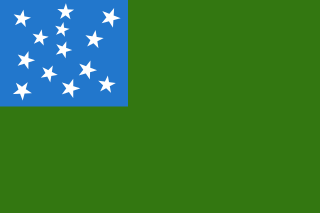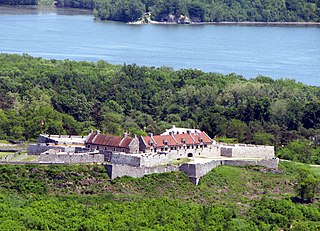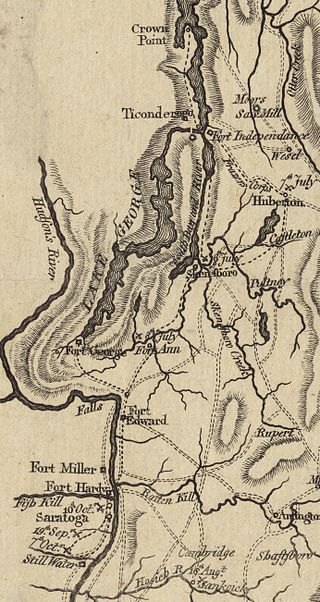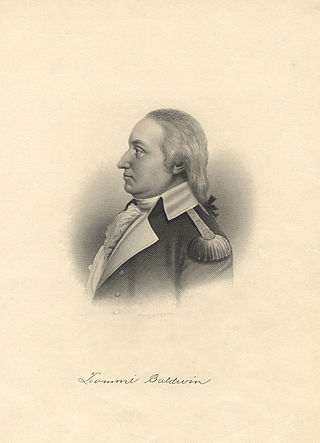
The Green Mountain Boys were a militia organization established in 1770 in the territory between the British provinces of New York and New Hampshire, known as the New Hampshire Grants and later in 1777 as the Vermont Republic. Headed by Ethan Allen and members of his extended family, it was instrumental in resisting New York's attempts to control the territory, over which it had won de jure control in a territorial dispute with New Hampshire.

Enoch Poor was a brigadier general in the Continental Army during the American Revolutionary War. He was a ship builder and merchant from Exeter, New Hampshire.

The 1777 Siege of Fort Ticonderoga occurred between the 2nd and 6 July 1777 at Fort Ticonderoga, near the southern end of Lake Champlain in the state of New York. Lieutenant General John Burgoyne's 8,000-man army occupied high ground above the fort, and nearly surrounded the defenses. These movements precipitated the occupying Continental Army, an under-strength force of 3,000 under the command of General Arthur St. Clair, to withdraw from Ticonderoga and the surrounding defenses. Some gunfire was exchanged, and there were some casualties, but there was no formal siege and no pitched battle. Burgoyne's army occupied Fort Ticonderoga and Mount Independence, the extensive fortifications on the Vermont side of the lake, without opposition on 6 July. Advance units pursued the retreating Americans.

The Battle of Hubbardton was an engagement in the Saratoga campaign of the American Revolutionary War fought in the village of Hubbardton, Vermont. Vermont was then a disputed territory sometimes called the New Hampshire Grants, claimed by New York, New Hampshire, and the newly organized, not yet recognized, but de facto independent government of Vermont. On the morning of July 7, 1777, British forces, under General Simon Fraser, caught up with the American rear guard of the forces retreating after the withdrawal from Fort Ticonderoga. It was the only battle in Vermont during the revolution.

Seth Warner was an American soldier. He was a Revolutionary War officer from Vermont who rose to rank of Continental colonel and was often given the duties of a brigade commander. He is best known for his leadership in the capture of Fort Crown Point, the Battle of Longueuil, the siege of Quebec, the retreat from Canada, and the battles of Hubbardton and Bennington.
The 3rd New Hampshire Regiment, also known as the 2nd Continental Regiment, was authorized on 22 May 1775, organized 1–8 June 1775, and adopted into the Continental Army on 14 June 1775, as the third of three regiments raised by the state of New Hampshire during the American Revolution. The enlistment dates for officers and rank and file soldiers extended to 23 April 1775, based on their response to the alarm for the Battles of Lexington and Concord.
The New Hampshire Militia was first organized in 1631 and lasted until 1641, when the area came under the jurisdiction of Massachusetts. After New Hampshire became an separate colony again in 1679, New Hampshire Colonial Governor John Cutt reorganized the militia on March 16, 1680, with one foot company apiece for the four major settlements in Portsmouth, Dover, Exeter and Hampton, and an artillery and cavalry company in Portsmouth. The King of England authorized the Provincial Governor to give commissions to persons who shall be best qualified for regulating and discipline of the militia. President Cutt placed Major Richard Waldron of Dover in command of the Militia. In 1879, the Militia was designated by the state as the New Hampshire National Guard.
Whitcomb's Rangers were authorized on October 15, 1776, and formed in November 1776 at Fort Ticonderoga in New York. The unit consisted of two companies of New Hampshire rangers for service with the Continental Army under the command of Benjamin Whitcomb, a veteran of Bedel's Regiment. They saw action at the Battle of Hubbardton, Battle of Bennington and the Battle of Saratoga. They were disbanded on January 1, 1781 at Coos, New Hampshire.
The 4th New York Regiment was one of four established by the New York Provincial Congress at the direction of the Continental Congress for the defense of King's Bridge where Manhattan Island joins the mainland, and of the Hudson River. The regiment would see action in the Invasion of Canada, New York Campaign, Battle of Saratoga, Battle of Monmouth and the Sullivan Expedition. The regiment was merged into the 2nd NY on January 1, 1781.
Long's Regiment was an infantry regiment that was raised on May 14, 1776 at New Castle, New Hampshire under Colonel Pierse Long for service with the Continental Army. The regiment was stationed at Fort Ticonderoga and Mount Independence on Lake Champlain and fought a delaying action at Fort Ann, New York on July 8, 1777 against the advance units of John Burgoyne's army. The regiment was disbanded at the end of July 1777 in northern New York as the one year enlistments of the men ran out before the main engagements of the Saratoga Campaign. Col. Long and some of the men of the regiment joined other New Hampshire regiments that fought at Saratoga.
The New Hampshire Provincial Regiment was a provincial military regiment made up of men from the New Hampshire Militia during the French and Indian War for service with the British Army in North America. It was first formed in 1754 with the start of hostilities with France.
Nathan Hale was an American Revolutionary War officer who fought in the Battle of Lexington and Concord, Battle of Bunker Hill, Siege of Fort Ticonderoga, and Battle of Hubbardton. Hale was taken prisoner by the British at Hubbardton and died in prison on September 23, 1780 at New Utrecht, Brooklyn, New York.
Hale's Regiment of Militia also known as the 15th New Hampshire Militia Regiment was at Fort Ticonderoga during the spring and summer of 1776 reinforcing the Continental Army garrison. The regiment was again called up on July 21, 1777 at Rindge, New Hampshire for Gen. John Stark's Brigade gathering at Charlestown, New Hampshire during the Saratoga Campaign. On August 16, 1777 Hale's regiment along with Hobart's Regiment and Stickney's Regiment made the main attack on Friedrich Baum's redoubt during the Battle of Bennington as Nichols' attacked from the rear (west) and Simonds' attacked from the south. Hale's Regiment would continue on in Stark's Brigade to cut off British Gen. John Burgoyne from retreat or supply after the Battle of Freeman's Farm. The regiment was also part of Gen. John Sullivan's army at the unsuccessful Battle of Rhode Island in 1778.

The New Hampshire Line was a formation in the Continental Army. The term "New Hampshire Line" referred to the quota of numbered infantry regiments assigned to New Hampshire at various times by the Continental Congress. These, along with similar contingents from the other twelve states, formed the Continental Line. For the promotion of senior officials, this concept is particularly important. Officers of the Continental Army below the rank of brigadier general were ordinarily ineligible for promotion except in the line of their own state.

Alexander Scammell was a Harvard educated attorney and an officer in the Continental Army during the American Revolutionary War. He was wounded on September 30, 1781, near Yorktown and subsequently died on October 6 in Williamsburg, Virginia, making him, a colonel, the highest ranking American officer killed during the Siege of Yorktown.

Mount Independence on Lake Champlain in Orwell, Vermont, was the site of extensive fortifications built during the American Revolutionary War by the American army to stop a British invasion. Construction began in July 1776, following the American defeat in Canada, and continued through the winter and spring of 1777. After the American retreat on July 5 and 6, 1777, British and Hessian troops occupied Mount Independence until November 1777.
The northern theater of the American Revolutionary War also known as the Northern Department of the Continental Army was a theater of operations during the American Revolutionary War.

The 26th Continental Regiment was an infantry unit of the Massachusetts Line during the American Revolutionary War. Gerrish's Regiment was raised in the early days of the war, and the regiment underwent name changes as the Continental Army was reorganized in 1776 and 1777. From 1777 onward, the unit was known as the 9th Massachusetts Regiment.







